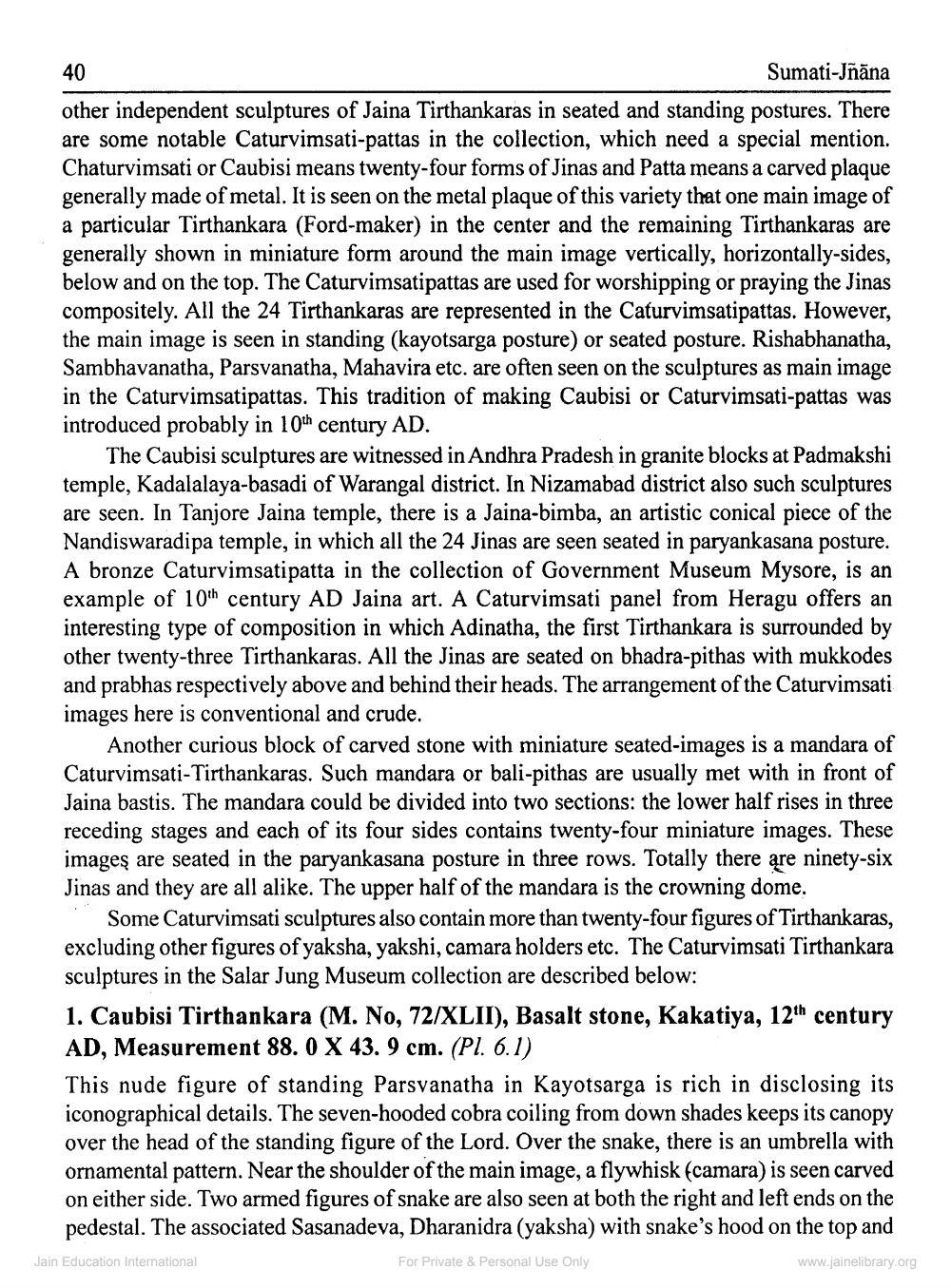________________
40
Sumati-jñāna
other independent sculptures of Jaina Tirthankaras in seated and standing postures. There are some notable Caturvimsati-pattas in the collection, which need a special mention. Chaturvimsati or Caubisi means twenty-four forms of Jinas and Patta means a carved plaque generally made of metal. It is seen on the metal plaque of this variety that one main image of a particular Tirthankara (Ford-maker) in the center and the remaining Tirthankaras are generally shown in miniature form around the main image vertically, horizontally-sides, below and on the top. The Caturvimsatipattas are used for worshipping or praying the Jinas compositely. All the 24 Tirthankaras are represented in the Caturvimsatipattas. However,
main image is seen in standing (kayotsarga posture) or seated posture. Rishabhanatha, Sambhavanatha, Parsvanatha, Mahavira etc. are often seen on the sculptures as main image in the Caturvimsatipattas. This tradition of making Caubisi or Caturvimsati-pattas was introduced probably in 10th century AD.
The Caubisi sculptures are witnessed in Andhra Pradesh in granite blocks at Padmakshi temple, Kadalalaya-basadi of Warangal district. In Nizamabad district also such sculptures are seen. In Tanjore Jaina temple, there is a Jaina-bimba, an artistic conical piece of the Nandiswaradipa temple, in which all the 24 Jinas are seen seated in paryankasana posture. A bronze Caturvimsatipatta in the collection of Government Museum Mysore, is an example of 10th century AD Jaina art. A Caturvimsati panel from Heragu offers ar interesting type of composition in which Adinatha, the first Tirthankara is surrounded by other twenty-three Tirthankaras. All the Jinas are seated on bhadra-pithas with mukkodes and prabhas respectively above and behind their heads. The arrangement of the Caturvimsati images here is conventional and crude.
Another curious block of carved stone with miniature seated-images is a mandara of Caturvimsati-Tirthankaras. Such mandara or bali-pithas are usually met with in front of Jaina bastis. The mandara could be divided into two sections: the lower half rises in three receding stages and each of its four sides contains twenty-four miniature images. These images are seated in the paryankasana posture in three rows. Totally there Jinas and they are all alike. The upper half of the mandara is the crowning dome.
Some Caturvimsati sculptures also contain more than twenty-four figures of Tirthankaras, excluding other figures of yaksha, yakshi, camara holders etc. The Caturvimsati Tirthankara sculptures in the Salar Jung Museum collection are described below: 1. Caubisi Tirthankara (M. No, 72/XLII), Basalt stone, Kakatiya, 12th century AD, Measurement 88.0 X 43. 9 cm. (Pl. 6.1) This nude figure of standing Parsvanatha in Kayotsarga is rich in disclosing its iconographical details. The seven-hooded cobra coiling from down shades keeps its canopy over the head of the standing figure of the Lord. Over the snake, there is an umbrella with ornamental pattern. Near the shoulder of the main image, a flywhisk (camara) is seen carved on either side. Two armed figures of snake are also seen at both the right and left ends on the pedestal. The associated Sasanadeva, Dharanidra (yaksha) with snake's hood on the top and
Jain Education International
For Private & Personal Use Only
www.jainelibrary.org




